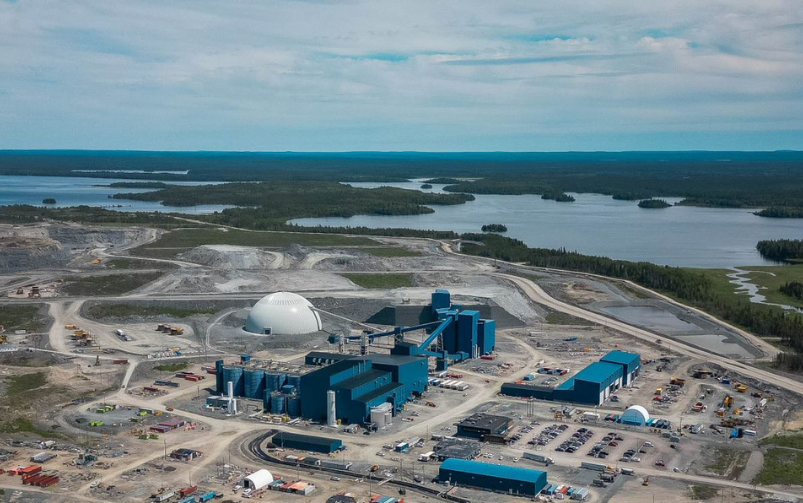After 27 years of delays, construction for Guinea’s Simandou iron ore project will commence in 2024, with the haulage road to the top of Mount Ouéléba constructed back in September 2023. Courtesy of Rio Tinto Simfer via X (the platform formerly known as Twitter).
Welcome back to your weekly mining news recap, where we catch you up on some of the news you may have missed. This week’s headlines include a mammoth discovery in North Dakota, New Gold’s high production figures for Rainy River and U.S. court decides not to toss Pebble ruling.
After 27 years of delays, the Simandou iron ore project in Guinea, host of the world’s largest undeveloped iron ore deposit, is set to commence development this year, as reported by the Financial Times. Due to the magnitude of the project with a current capital cost estimate of US$11.6 billion, Rio Tinto is developing the project under a joint venture partnership with the Guinean government and several other companies. Construction is expected to begin after Rio Tinto’s state-owned Chinese partners acquire final approval from Beijing.
Fourteen proposed critical mineral mines and two proposed mine extensions in B.C. are expected to yield nearly $800 billion over several decades, and represent $36.5 billion in near-term investment, over 300,000 person-years of employment and almost $11 billion in tax revenues. This is according to a study conducted for the Mining Association of British Columbia (MABC).
Alberta has announced it will discontinue coal-powered electricity sooner than expected, which has left some communities concerned about the economic impact of layoffs at coal operations, as reported by CBC News. Alberta is reportedly set to stop using coal for electricity generation later this year. In 2015, the NDP-led government planned to finalize the phase-out by 2030, which at the time was still considered by some to be an ambitious goal. The phase-out greatly impacted Alberta’s Sheerness coal mine, with the mine forced to close in February 2021 after 25 years of operations.
Hidden for thousands of years, woolly mammoth remains were uncovered by North Dakota coal miners, according to The Associated Press. The initial discovery, a seven-foot-long tusk, weighing in at over 50 pounds, was found in May 2023 buried 40 feet deep at North American Coal Corporation’s Freedom mine near Beulah, and is now estimated to be anywhere from 10,000 to 100,000 years old. A later dig around the site revealed over 20 more bones, which may make it the most complete mammoth skeleton ever found in the state.
Gold production at New Gold’s Rainy River mine in Ontario reached the high end of its guidance for 2023, coming in at 259,679 ounces, as reported by Northern Ontario Business. Underground development at the mine is steadily advancing, with New Gold noting that the main underground zone is on track for its first gold production later this year.
The U.S. Supreme Court denied Alaska’s appeal to rescind the Environmental Protection Agency’s (EPA) rejection of the proposed Pebble project, as reported by NS Energy. The project’s owner, Canada-based Northern Dynasty Metals, planned to develop one of the world’s largest undeveloped copper deposits in the Bristol Bay watershed, which also happens to be home to the world’s largest sockeye salmon fishery and 25 Indigenous communities. The EPA applied rarely used authority provided by the Clean Water Act to suspend the proposal last year.
First Nations residents of Yukon’s Kaska territory received a partial victory from Yukon’s Supreme Court after asserting they were not adequately engaged with during the environmental assessment process of the proposed Kudz Ze Kayah mine, as reported by CBC News. The court stated that while the Crown worked hard to involve Kaska’s Indigenous community, it did not pay proper attention to a final written submission from the community. The court ultimately ordered that the government’s approval of the mine be set aside until after a final consultation meeting later this winter.
At a mining conference in Saudi Arabia, Mark Cutifani of Vale Base Metals dusted off the proposed merger of Vale and Glencore’s respective nickel mining projects, as reported by Northern Ontario Business. The companies have nickel operations adjacent to one another, and a partnership could generate estimated annual cost savings up to US$550 million. Such a merger between the two companies has been a matter of discussion since at least 2006.
A recent update from Quebec’s Nouveau Monde Graphite (NMG) revealed plans to pilot and test electric equipment, starting with a wheel loader, at its Matawinie open-pit graphite mine, wrote Tijana Mitrovic in the December/January issue of CIM Magazine . Following an initial collaboration agreement back in 2021 between Caterpillar and NMG, the partnership has progressed and Caterpillar has agreed to supply electric-powered heavy mining equipment to meet NMG’s goal of fully electrifying all equipment during the first five years of the mine operations. The development could establish Matawinie as the world’s first all-electric open-pit mine.
That’s all for this week. If you’ve got feedback, you can always reach us at editor@cim.org. If you’ve got something to add, why not join the conversation on our Facebook, Twitter, LinkedIn or Instagram pages?




